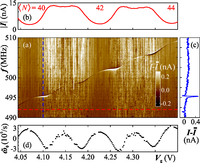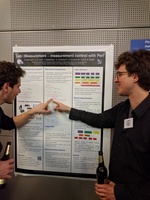We're happy to announce that our article "Lab::Measurement — a portable and extensible framework for controlling lab equipment and conducting measurements", describing our measurement software package Lab::Measurement, has been published in Computer Physics Communications.
Lab::Measurement is a collection of object-oriented Perl 5 modules for controlling lab instruments, performing measurements, and recording and plotting the resultant data. Its operating system independent driver stack makes it possible to use nearly identical measurement scripts both on Linux and Windows. Foreground operation with live plotting and background operation for, e.g., process control are supported. For more details, please read our article, visit the Lab::Measurement homepage, or visit Lab::Measurement on CPAN!
"Lab::Measurement - a portable and extensible framework for controlling lab equipment and conducting measurements"
S. Reinhardt, C. Butschkow, S. Geissler, A. Dirnaichner, F. Olbrich, C. Lane, D. Schröer, and A. K. Hüttel
Comp. Phys. Comm. 234, 216 (2019); arXiv:1804.03321
(PDF)
Thursday, October 18, 2018
Friday, May 18, 2018
PRL accepted: Nanomechanical characterization of the Kondo charge dynamics in a carbon nanotube
Today's great news is that our manuscript "Nanomechanical characterization of the Kondo charge dynamics in a carbon nanotube" has been accepted for publication by Physical Review Letters.
The Kondo effect is a many-body phenomenon at low temperature that results from a quantum state degeneracy, as, e.g., the one of spin states in absence of a magnetic field. In its simplest case, it makes a quantum dot, in our case a carbon nanotube with some trapped electrons on it, behave very different for an even and an odd number of electrons. At an even number of trapped electrons, no current can flow through the nanotube, since temperature and applied bias voltage are too low to charge it with one more elementary charge; this phenomenon is called Coulomb blockade. Strikingly, at odd electron number, when two degenerate quantum states in the nanotube are available, Coulomb blockade seems not to matter, and a large current can flow. Theory explains this by assuming that a localized electron couples to electrons in the contacts, forming a combined, delocalized singlet quantum state.
What carries the Kondo-enhanced current, and how does the electric charge now accumulate in the carbon nanotube? We use the vibration of the macromolecule to measure this. As also in the case of, e.g., a guitar string, the resonance frequency of a nanotube changes when you pull on it; in the case of the carbon nanotube this is sensitive enough to resolve fractions of the force caused by a single elementary charge. From the vibration frequency, as function of the electrostatic potential, we calculate the average number of electrons on the nanotube, and can then compare the odd and even number cases.
A surprising result of our evaluation is that the charge trapped on the nanotube behaves the same way in the even and odd occupation case, even though the current through it is completely different. Sequential tunneling of electrons can model the charge accumulation, and with it the mechanical behaviour. The large Kondo current is carried by virtual occupation of the nanotube alone, i.e., electrons tunneling on and immediately off again so they do not contribute to the charge on it.
"Nanomechanical Characterization of the Kondo Charge Dynamics in a Carbon Nanotube"
K. J. G. Götz, D. R. Schmid, F. J. Schupp, P. L. Stiller, Ch. Strunk, and A. K. Hüttel
Physical Review Letters 120, 246802 (2018); arXiv:1802.00522 (PDF, HTML, supplementary information)
The Kondo effect is a many-body phenomenon at low temperature that results from a quantum state degeneracy, as, e.g., the one of spin states in absence of a magnetic field. In its simplest case, it makes a quantum dot, in our case a carbon nanotube with some trapped electrons on it, behave very different for an even and an odd number of electrons. At an even number of trapped electrons, no current can flow through the nanotube, since temperature and applied bias voltage are too low to charge it with one more elementary charge; this phenomenon is called Coulomb blockade. Strikingly, at odd electron number, when two degenerate quantum states in the nanotube are available, Coulomb blockade seems not to matter, and a large current can flow. Theory explains this by assuming that a localized electron couples to electrons in the contacts, forming a combined, delocalized singlet quantum state.
What carries the Kondo-enhanced current, and how does the electric charge now accumulate in the carbon nanotube? We use the vibration of the macromolecule to measure this. As also in the case of, e.g., a guitar string, the resonance frequency of a nanotube changes when you pull on it; in the case of the carbon nanotube this is sensitive enough to resolve fractions of the force caused by a single elementary charge. From the vibration frequency, as function of the electrostatic potential, we calculate the average number of electrons on the nanotube, and can then compare the odd and even number cases.
A surprising result of our evaluation is that the charge trapped on the nanotube behaves the same way in the even and odd occupation case, even though the current through it is completely different. Sequential tunneling of electrons can model the charge accumulation, and with it the mechanical behaviour. The large Kondo current is carried by virtual occupation of the nanotube alone, i.e., electrons tunneling on and immediately off again so they do not contribute to the charge on it.
"Nanomechanical Characterization of the Kondo Charge Dynamics in a Carbon Nanotube"
K. J. G. Götz, D. R. Schmid, F. J. Schupp, P. L. Stiller, Ch. Strunk, and A. K. Hüttel
Physical Review Letters 120, 246802 (2018); arXiv:1802.00522 (PDF, HTML, supplementary information)
Wednesday, April 11, 2018
Manuscript on Lab::Measurement submitted for publication
Today's news is that we have submitted a manuscript for publication, describing Lab::Measurement and with it our approach towards fast, flexible, and platform-independent measuring with Perl! The manuscript mainly focuses on the new, Moose-based class hierarchy. We have uploaded it to arXiv as well; here is the (for now) full bibliographic information of the preprint:
"Lab::Measurement - a portable and extensible framework for controlling lab equipment and conducting measurements"If you're using Lab::Measurement in your lab, and this results in some nice publication, then we'd be very grateful for a citation of our work - for now the preprint, and later hopefully the accepted version.
S. Reinhardt, C. Butschkow, S. Geissler, A. Dirnaichner, F. Olbrich, C. Lane, D. Schröer, and A. K. Hüttel
submitted for publication; arXiv:1804.03321 (PDF, BibTeX entry)
Sunday, March 18, 2018
DPG 2018, the proof: Yes we've been in Berlin!
The 2018 spring meeting of the DPG condensed matter physics section in Berlin is over, and we've all listened to interesting talks and seen exciting physics. And we've also presented the Lab::Measurement poster! Here's the photo proof of Simon explaining our software... click on the image or the link for a larger version!
Monday, January 8, 2018
FOSDEM 2018 talk: Perl in the Physics Lab
FOSDEM 2018, the "Free and Open Source Developers' European Meeting", takes place 3-4 February at Universite Libre de Bruxelles, Campus Solbosch, Brussels - and our measurement control software Lab::Measurement will be presented there in the Perl devrooom! As all of FOSDEM, the talk will also be streamed live and archived; more details on this follow later. Here's the abstract:
Perl in the Physics Lab
Andreas K. Hüttel
Track: Perl Programming Languages devroom
Room: K.4.601
Day: Sunday
Start: 11:00
End: 11:40
Let's visit our university lab. We work on low-temperature nanophysics and transport spectroscopy, typically measuring current through experimental chip structures. That involves cooling and temperature control, dc voltage sources, multimeters, high-frequency sources, superconducting magnets, and a lot more fun equipment. A desktop computer controls the experiment and records and evaluates data.
Some people (like me) want to use Linux, some want to use Windows. Not everyone knows Perl, not everyone has equal programming skills, not everyone knows equally much about the measurement hardware. I'm going to present our solution for this, Lab::Measurement. We implement a layer structure of Perl modules, all the way from the hardware access and the implementation of device-specific command sets to high level measurement control with live plotting and metadata tracking. Current work focuses on a port of the entire stack to Moose, to simplify and improve the code.



